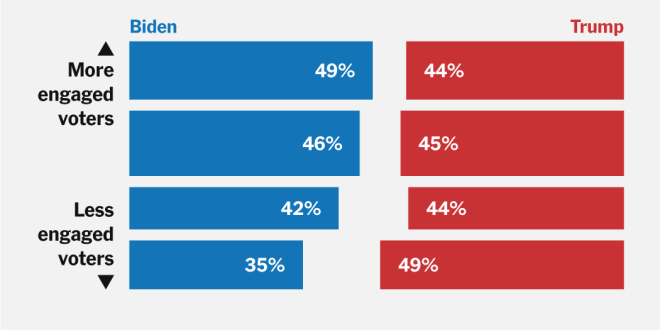The new turnout dynamic has already upset these familiar political goals. Suddenly, many voters whom Democrats took for granted are now considered “persuasion” targets, as if they were traditional swing voters.
Republicans, meanwhile, watched a widely expected “red wave” fail to materialize in the 2022 midterm elections, despite a wave of new voting laws enacted by Republican state legislatures. Last summer, Republicans in Ohio scheduled a referendum on an irregular date in hopes of sidestepping the public’s ability to vote for abortion rights, only to see the referendum lose by double digits.
The evidence for Democrats’ strength among high-frequency voters has regularly been on display on Tuesday nights, as they have cheered the results of special elections. While Mr. Trump has struggled to unify highly engaged Republican voters, Democrats have excelled in such elections, in an environment that might appear unfriendly: The electorate is disproportionately white, half of voters are seniors, and virtually no young people show up at all.
The signs of Democratic weakness among infrequent voters, who skip low-turnout special and primary elections, is harder to find. It is obvious in the polls — and not just in the Times/Siena polling — but there are hints of it everywhere, if you look carefully.
While Democrats beat expectations in the 2022 midterms, they fared worse than in special elections held in the same districts just a few months earlier. Similarly, Mr. Trump managed to beat expectations and nearly won in 2020 — in the highest-turnout election in a century — in no small part because of surprising strength among lower-turnout Hispanic voters. New voter registration trends have also been increasingly favorable to Republicans, even though new registrants are disproportionately young and nonwhite.
In Pennsylvania, where Democrats enacted automatic voter registration last year, new registrants have affiliated with Republicans over Democrats by six percentage points. Before automatic registration was enacted, Mr. Trump sent an all-caps message on social media decrying the law.
Demographics are not the explanation for Mr. Trump’s strength among infrequent voters. Although these voters are less likely to hold a college degree, they’re still disproportionately young and nonwhite. They would be expected to be Democratic-leaning if they had the same preferences as demographically similar voters who turn out more regularly in elections. Instead, infrequent voters of every demographic group seem less likely to support Mr. Biden in the early polls.
On paper, many of the disengaged voters behind Mr. Biden’s weakness look as if they should be loyal Democrats. Many are registered as Democrats and still identify as Democratic-leaning voters. They support abortion rights, back Democratic candidates for U.S. Senate and are from Democratic-leaning constituencies, like young, Black and Hispanic voters.
But their attitudes are more complicated. They are much more likely to say the economy is “poor” than Democratic primary voters, and they’re much likelier to disapprove of Mr. Biden’s job performance. They want fundamental changes to America, not merely a promised return to normalcy. Some even mistakenly hold Mr. Biden more responsible than Mr. Trump for the Supreme Court’s decision to overturn Roe v. Wade — perhaps out of a sense that the president should have been able to do something about it. They get their news from social media, not MSNBC.
 Top Naija News – Nigeria News, Nigerian News & Top Stories Top Naija News – Nigerian Newspapers, Nigerian News. topnaijanews is a daily Nigerian newspaper covering Latest News, Breaking News, Entertainment, Sports, Lifestyle and Politics.
Top Naija News – Nigeria News, Nigerian News & Top Stories Top Naija News – Nigerian Newspapers, Nigerian News. topnaijanews is a daily Nigerian newspaper covering Latest News, Breaking News, Entertainment, Sports, Lifestyle and Politics.




